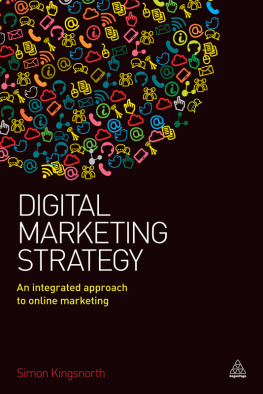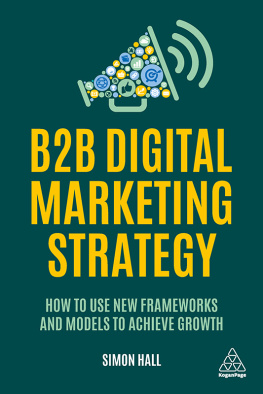 Simon Kingsnorth is a strategic marketing leader who has built and led marketing departments and consulted to businesses across the world. He has specialized in digital for many years and run campaigns across all digital channels but also has experience running most offline channels. He has a passion for digital-first cultures but above all has a belief that integrated, client-centric strategies should be the focus for most organizations.
Simon Kingsnorth is a strategic marketing leader who has built and led marketing departments and consulted to businesses across the world. He has specialized in digital for many years and run campaigns across all digital channels but also has experience running most offline channels. He has a passion for digital-first cultures but above all has a belief that integrated, client-centric strategies should be the focus for most organizations.
Simon has worked client-side for a wide range of organizations including start-ups, small and medium-sized enterprises (SMEs) and global businesses across a range of business to consumer (B2C) and business to business (B2B) industries and has also been fortunate enough to work with many leading agencies. He is a contributing author to the books Understanding Digital Marketing and Understanding Social Media .
Simon also has too many hobbies to count including photography, music and history but the things Simon is most proud of are his two wonderful boys.
Glen Conybeare
 Glen is Chief Commercial Officer at international digital marketing agency Stickyeyes ( stickyeyes.com ). A member of the executive board, Glen is responsible for client services and is heavily involved in business development. Glen has a wealth of international client and agency-side experience, having worked in the UK, United States, Sweden and Gibraltar, and has previously held a number of senior and board-level positions at companies such as digital media agency i-level and analytics company Touch Clarity (acquired by Omniture) as well as co-founding real-time ad optimization company Cognitive Match (sold to Magnetic Inc). He lives in Leeds with his wife and two young daughters and therefore has no free time for hobbies.
Glen is Chief Commercial Officer at international digital marketing agency Stickyeyes ( stickyeyes.com ). A member of the executive board, Glen is responsible for client services and is heavily involved in business development. Glen has a wealth of international client and agency-side experience, having worked in the UK, United States, Sweden and Gibraltar, and has previously held a number of senior and board-level positions at companies such as digital media agency i-level and analytics company Touch Clarity (acquired by Omniture) as well as co-founding real-time ad optimization company Cognitive Match (sold to Magnetic Inc). He lives in Leeds with his wife and two young daughters and therefore has no free time for hobbies.
Murray Cox
 Murray Cox is Digital Strategy Director at Pancentric Digital ( www.pancentric.com ) in London where he helps clients make smarter digital decisions to transform their businesses. Prior to going agency-side Murray was a digital journalist in both the UK and Australia for the BBC, Australian Associated Press and the Special Broadcast Service. Murray went digital in 1998 as part of the launch team of the MSN network and has since been involved as the media and many other industries have digitally transformed. He has an MBA from Strathclyde University.
Murray Cox is Digital Strategy Director at Pancentric Digital ( www.pancentric.com ) in London where he helps clients make smarter digital decisions to transform their businesses. Prior to going agency-side Murray was a digital journalist in both the UK and Australia for the BBC, Australian Associated Press and the Special Broadcast Service. Murray went digital in 1998 as part of the launch team of the MSN network and has since been involved as the media and many other industries have digitally transformed. He has an MBA from Strathclyde University.
James Bourner
 James is a digital advertising expert who works for the international independent agency Jellyfish. James has worked for many companies in a range of sectors and his expertise includes online advertising, digital marketing, content monetization and e-commerce. His current passion is programmatic buying.
James is a digital advertising expert who works for the international independent agency Jellyfish. James has worked for many companies in a range of sectors and his expertise includes online advertising, digital marketing, content monetization and e-commerce. His current passion is programmatic buying.
01
What we will cover in this chapter
This chapter is intended to give you a background into digital marketing, some of the established models used in constructing a marketing strategy and a focus on how they apply to digital. The key areas covered in this chapter are:
- A history of digital marketing
- The 4 Ps of marketing
- Porters five forces
- Brand or perceptual positioning map
- Customer lifetime value
- Segmentation
- Boston Consulting Group matrix
Chapter goals
By the end of this chapter you should understand some of the key marketing and business models that will help to shape your strategy. You should have an overview of the history of digital marketing to give some perspective to your strategic plan. You should also gain an understanding of consumer behaviour, market factors, segmentation, lifetime value and the 4 Ps of marketing.
As with any book, and indeed any marketing strategy, the best place to begin is at the beginning. Digital marketing is an ever evolving and growing beast and one that continues to spread its tentacles deep into the processes that organizations have lived by for decades. That all sounds very dramatic but the truth is that it is simply aligned with the direction of travel of the modern world. Digital marketing is (or should be) a part of almost every key business decision from product development and pricing through to public relations (PR) and even recruitment. We touch on why throughout the book.
Now is an exciting time to be in digital marketing.
Digital marketing is often confused with online marketing. As we moved into the 21st century most businesses had, or were in the final throws of, developing a web presence. E-mail was commonplace and there was technology allowing people to manage this fairly easily. Customer relationship management (CRM) systems had been in place for some time to manage databases. Some companies were placing banners on websites with a similar approach to press advertising. Forward-thinking companies were working on their search engine strategy and even working with some affiliates. All of this was online marketing and, in time, online marketing teams and specialists would begin to appear.
So what has changed? The social media revolution has completely changed the internet and consumer behaviour. The penetration of broadband has increased speed, internet usage and user expectation with over 40 per cent of the world now online and over 90 per cent in many countries (Internet World Stats, 2015). Analytics has grown to the level where we can understand our consumers behaviour in real time, including not just their usage statistics but also their demographics and even interests. Mobile has gone smart and tablets have stormed onto the scene and both of these changes have brought along apps. Touchscreen is becoming increasingly common across all devices. Google has become an enormous organization and owns search globally. TVs have gone smart and Bluetooth opens up another level of possibilities. With a naturally ageing population there is now only a very small percentage who are technophobes simply due to age. I could go on, but it is clear to see that digital is now much broader than the online channels of 15 years ago and must be embedded into everything we do. We will discuss the modern digital marketing channels in more detail in .
One key point that needs to be made at this early stage is that the focus of this book is on digital marketing and that the word marketing is as important as the word digital. Many organizations have moved towards creating digital marketing departments and digital departments that are separate from their marketing departments. It is crucial now, more so than ever, that digital marketing is an integral part of all marketing activities. This includes PR, creative direction, brand, CRM, retention, product development, pricing, proposition, communications the entire marketing mix. Creating a silo for digital activity is very dangerous and only through truly understanding the strategic benefits of fully integrating your marketing from day one will you succeed.
Digital marketing first appeared as a term in the 1990s but, as mentioned above, it was a very different world then. Web 1.0 was primarily static content with very little interaction and no real communities. The first banner advertising started in 1993 and the first web crawler (called Webcrawler) was created in 1994 this was the beginning of search engine optimization (SEO) as we know it. This may not seem a deep and distant past but when we consider that this was four years before Google launched, over 10 years before YouTube, and that social media was not even a dream at this point, it shows just how far we have come in a short time.












 Simon Kingsnorth is a strategic marketing leader who has built and led marketing departments and consulted to businesses across the world. He has specialized in digital for many years and run campaigns across all digital channels but also has experience running most offline channels. He has a passion for digital-first cultures but above all has a belief that integrated, client-centric strategies should be the focus for most organizations.
Simon Kingsnorth is a strategic marketing leader who has built and led marketing departments and consulted to businesses across the world. He has specialized in digital for many years and run campaigns across all digital channels but also has experience running most offline channels. He has a passion for digital-first cultures but above all has a belief that integrated, client-centric strategies should be the focus for most organizations. Glen is Chief Commercial Officer at international digital marketing agency Stickyeyes ( stickyeyes.com ). A member of the executive board, Glen is responsible for client services and is heavily involved in business development. Glen has a wealth of international client and agency-side experience, having worked in the UK, United States, Sweden and Gibraltar, and has previously held a number of senior and board-level positions at companies such as digital media agency i-level and analytics company Touch Clarity (acquired by Omniture) as well as co-founding real-time ad optimization company Cognitive Match (sold to Magnetic Inc). He lives in Leeds with his wife and two young daughters and therefore has no free time for hobbies.
Glen is Chief Commercial Officer at international digital marketing agency Stickyeyes ( stickyeyes.com ). A member of the executive board, Glen is responsible for client services and is heavily involved in business development. Glen has a wealth of international client and agency-side experience, having worked in the UK, United States, Sweden and Gibraltar, and has previously held a number of senior and board-level positions at companies such as digital media agency i-level and analytics company Touch Clarity (acquired by Omniture) as well as co-founding real-time ad optimization company Cognitive Match (sold to Magnetic Inc). He lives in Leeds with his wife and two young daughters and therefore has no free time for hobbies. Murray Cox is Digital Strategy Director at Pancentric Digital ( www.pancentric.com ) in London where he helps clients make smarter digital decisions to transform their businesses. Prior to going agency-side Murray was a digital journalist in both the UK and Australia for the BBC, Australian Associated Press and the Special Broadcast Service. Murray went digital in 1998 as part of the launch team of the MSN network and has since been involved as the media and many other industries have digitally transformed. He has an MBA from Strathclyde University.
Murray Cox is Digital Strategy Director at Pancentric Digital ( www.pancentric.com ) in London where he helps clients make smarter digital decisions to transform their businesses. Prior to going agency-side Murray was a digital journalist in both the UK and Australia for the BBC, Australian Associated Press and the Special Broadcast Service. Murray went digital in 1998 as part of the launch team of the MSN network and has since been involved as the media and many other industries have digitally transformed. He has an MBA from Strathclyde University. James is a digital advertising expert who works for the international independent agency Jellyfish. James has worked for many companies in a range of sectors and his expertise includes online advertising, digital marketing, content monetization and e-commerce. His current passion is programmatic buying.
James is a digital advertising expert who works for the international independent agency Jellyfish. James has worked for many companies in a range of sectors and his expertise includes online advertising, digital marketing, content monetization and e-commerce. His current passion is programmatic buying.